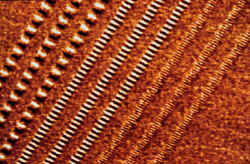Flipping Atoms Fast

The slowest part of a typical computer is the hard drive, which is no surprise to anyone who has waited for a PC to start up. There are several steps involved in storing and retrieving data from a disk, but the process of encoding information into magnetically aligned atoms is reaching its practical limits of speed. In the 3 May PRL a team demonstrates reversing the alignment of groups of atoms in as little as 100 picoseconds–at least ten times faster than today’s disk drives–by using ultrashort laser pulses to influence the material’s magnetic properties. The technique allows the team to investigate the fundamental interactions involved in such fast magnetic switching, and it may lead to extremely fast data storage devices in the future.
A disk drive “writes” a one or zero by applying a magnetic field to a small region on the disk, which forces the internal “bar magnets” (magnetic moments) of those atoms to align parallel to the field. There is a limit to the speed with which the moment-orienting field can be turned on and off by conventional electronics, but the intrinsic speed limit on flipping magnetic moments may be much higher. Arto Nurmikko of Brown University in Providence, RI, says it’s like asking, “How quickly can I turn a compass needle around?”
To address that question, Nurmikko and his colleagues at Brown and the IBM Almaden Research Center in San Jose, CA, took advantage of ultrafast laser pulse technology. They focused the laser on a sandwich of two materials: The first ( ) is anti-ferromagnetic–the atoms in each layer of tend to align with one another but opposite to the direction of neighboring layers of . The other material ( ) is ferromagnetic–all of its atoms tend to align with an external field. This combination has the special property that the last layer, the one at the interface of the two materials, provides a strong enough magnetic field to align all of the ferromagnetic material. The field created by that last layer of –only a few atoms thick–acts as a “built-in” external field on the . The researchers used a subpicosecond laser pulse to disrupt the coupling between the two materials, freeing the ferromagnet to respond to an oppositely-directed field they had applied from the outside. The team recorded the quick magnetic reversal with a weak laser pulse whose polarization was affected by the direction of atomic moments in the sample.
The whole reversal process occurred in roughly 100 picoseconds ( s), whereas conventional disk drives take more than a nanosecond to flip magnetic moments. “Magneto-optical” disk drives also make use of laser pulses in writing data, but in that technology the light heats the atoms to erase their “memory” of any previous orientation before a magnetic field re-aligns them. The heating process makes those drives even slower than conventional hard drives, although they have other advantages for storing large amounts of data.
While the concept could some day be used in fast data storage, the team is using it to study the process of moment-flipping. Many physicists have studied the reversal of a single atom’s magnetic moment, but according to Nurmikko, the collective process of flipping the moments of many thousands of atoms at once is not well understood at a fundamental level. Progress in the basic physics, he says, will certainly advance the technology.
“They have a very neat technique,” says Dieter Weller, an IBM Almaden researcher who was not involved in the experiments. Although applications of the method are far away, “it’s certainly a new avenue of thinking,” he says, especially the “great idea” of creating a “built-in” magnetic field as part of the material.


